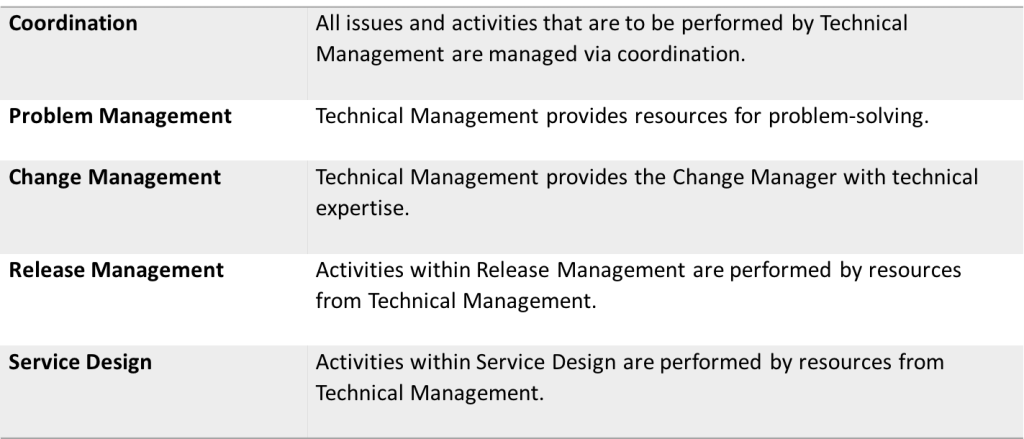Technical Management is the function which is most similar to an organizational unit. It is here the technical expertise is located in the form of personnel, and in many IT organizations, it is equivalent to the operation department or the infrastructure department.
The entire technical IT environment requires administration. If something goes wrong, it needs to be restored and if something new has to be set up, it needs to be designed and constructed. Performing these activities requires expertise in relation to all the products and components included in the IT environment. It is the responsibility of the Technical Management function that this expertise is available for the IT organization.
Access to expertise does not necessarily mean that it is in the form of employed staff, it can equally be in the form of suppliers or contracted consultants.


Purpose
The purpose of Technical Management is to be the IT organization’s experts in the technical IT environment. It entails providing technical expertise for design, testing, deployment, ongoing maintenance and continual improvement of the IT services that are produced.
The function should also provide all technical resources to other parts of the IT organization. Technical Management ensures that staff and contracted resources have sufficient training and knowledge to participate in projects, maintain the IT environment and implement improvement measures. In fulfilling these purposes, Technical Management ensures that the IT organization has access to the amount of resources and the level of expertise that is required in order to meet the levels agreed with the business.
Responsibility
The overall task of Technical Management is to plan, operate and maintain the technical IT environment. This also includes continuously strive to achieve a stable and cost-effective IT environment as possible.
Technical Management’s responsibility comprises, but is not limited to:
- Acting as second line support for the technical part of the IT environment
- Providing expert skills in relation to technical components in the IT environment
- Processing orders that are received via the Request Fulfilment process
- Providing resources for the Problem Management process, which can locate problems in technical components
- Staffing projects and major activities where technical expertise is needed
- Acting as experts and advisers for technical development
- Supporting the Change Management process with expertise in the technical IT environment
- Performing activities in the Release Management process.
- Conducting training courses and producing training material and documentation targeted at users and Service Desk
- Taking responsibility that the technical documentation of the IT environment is complete and correct
Organization and working method
In small and medium-sized IT organizations, Technical Management is usually a single organizational unit. However, the IT infrastructure consists of many different technical areas. Some of them can be merged together and staffed by generalists while others require specialists. Each organization must staff the function in a way which suits its own structure and size. The function’s responsibility is to provide expert skills, not necessarily to have them within its own organization. This means that for some specific areas it is more suitable to bring in expertise through subcontractors instead of employing staff. It might be areas where expert skills are hard to recruit or where there are not many issues, with the area simultaneously being narrow and not possible to be staffed by generalists.
The staff included in Technical Management are often in demand within the IT organization, which means they have a higher workload. All activities and issues which need a resource from Technical Management should therefore be managed via the Coordination process. This elevates the priority to an overall level and relieves individual resources.
Input
The overall input to Technical Management is issues which arrive via Coordination. More specifically, input consists of:
- Problems
- Orders
- Operational Maintenance
- Projects
- Improvement activities
Output
The overall output from Technical Management is a stable and cost-effective IT environment. More specifically, output consists of:
- Resolved problems
- Processed orders
- Operational Maintenance performed
- Improvement activities implemented
- Changes deployed
Documentation
All documents produced by the function should be available in a business system. The most important documents are:
- Technical documentation of products and components
- Operational Maintenance for products and components
- Information regarding technical solutions in the IT environment
- Information regarding the suppliers that are a part of the function
Relationships with other processes and functions
Technical Management has links to many other processes and functions. The most common are listed here:


